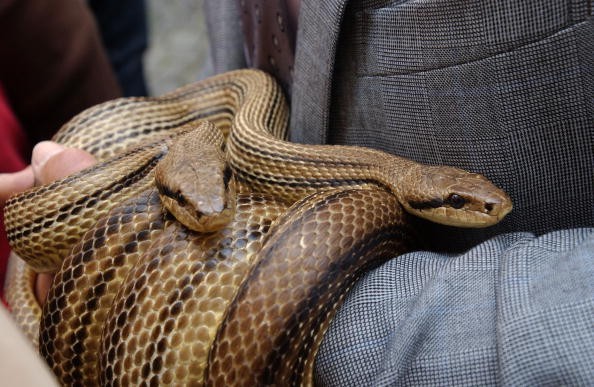Ancient Snake Fossil Surprisingly Shows Off Four Legs
| Janice Teh | | Jul 24, 2015 07:21 AM EDT |
(Photo : Getty Images) Ancient snake fossil had four legs.
A recent report from Live Science about the ancestors of our modern snakes has an unexpected twist. David Martill from the University of Portsmouth, narrated to Live Science on personally seeing an ancient snake fossil that had four tiny legs.
Like Us on Facebook
Martill says that he and his students were at the Burgermeister Muller Museum in Solnhofen, Germany. He was pointing out towards the ancient creature fossils in the museum when a snake-like looking fossil caught his attention.
What Martill found in the Solnhofen Museum was what he called "once in a lifetime discovery." He saw a creature that quite positively resembled a small snake, only this one had something that most of the other ancient snake fossils did not have — four legs, front and hind tiny legs.
National Geographic further stated that the four-legged ancient snake was discovered in South America. The rock where it got trapped would date to the early part of the Cretaceous period. There have been other snake fossils found during the Cretaceous period, but this particular four-legged snake is the first ancient snake to be found in South America.
The four-legged ancient snake was aptly called "tetrapodophis." It literally translates to four-legged snake. Apparently, all four legs of the tetrapodophis weren't really made for walking, but it could be possible that those legs were helpful in groping the prey caught by this marvelous ancient snake.
Nicholas Longrich, a paleontologist from the University of Bath was interviewed by CS Monitor on the tetrapodophis. Longrich's theory was that these four tiny and obscure legs may have been helpful in snagging prey. He also had another theory on how those tiny legs were used — for mating. When the tetrapodophis were with their mates, those legs would be helpful to hold their mates better.
The research team headed by Longrich also told CS Monitor of another fossil that also had an ancient snake very similar to the tetrapodophis. Since it possibly existed during the same time the tetrapodophis did, it was aptly given the scientific name "tetrapodophis amplectus." It was still found in South America, in the Crato Formation in Brazil. However, some of the bones in the skull were missing. Almost each bone of this new ancient snake matched to what Martill found in the German museum.
TagsFossils, snake fossils, ancient snake with legs, ancient reptiles
©2015 Chinatopix All rights reserved. Do not reproduce without permission
EDITOR'S PICKS
-

Did the Trump administration just announce plans for a trade war with ‘hostile’ China and Russia?
-

US Senate passes Taiwan travel bill slammed by China
-

As Yan Sihong’s family grieves, here are other Chinese students who went missing abroad. Some have never been found
-

Beijing blasts Western critics who ‘smear China’ with the term sharp power
-

China Envoy Seeks to Defuse Tensions With U.S. as a Trade War Brews
-

Singapore's Deputy PM Provides Bitcoin Vote of Confidence Amid China's Blanket Bans
-

China warns investors over risks in overseas virtual currency trading
-

Chinese government most trustworthy: survey
-

Kashima Antlers On Course For Back-To-Back Titles
MOST POPULAR
LATEST NEWS
Zhou Yongkang: China's Former Security Chief Sentenced to Life in Prison

China's former Chief of the Ministry of Public Security, Zhou Yongkang, has been given a life sentence after he was found guilty of abusing his office, bribery and deliberately ... Full Article
TRENDING STORY

China Pork Prices Expected to Stabilize As The Supplies Recover

Elephone P9000 Smartphone is now on Sale on Amazon India

There's a Big Chance Cliffhangers Won't Still Be Resolved When Grey's Anatomy Season 13 Returns

Supreme Court Ruled on Samsung vs Apple Dispute for Patent Infringement

Microsoft Surface Pro 5 Rumors and Release Date: What is the Latest?










